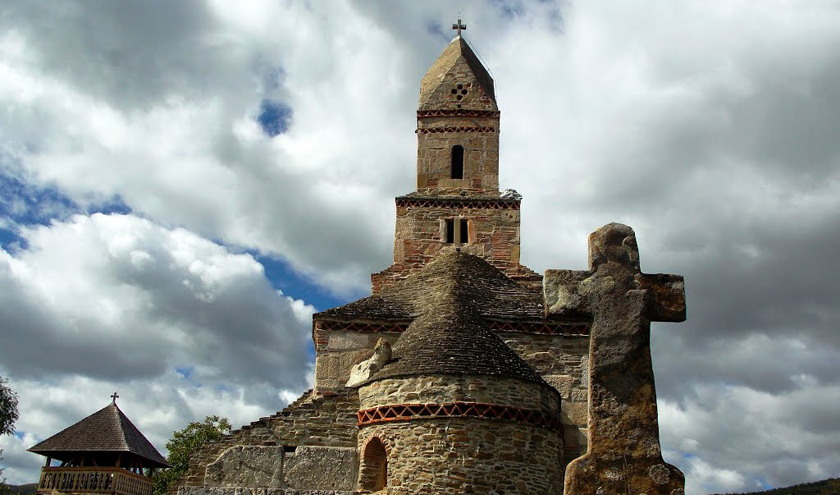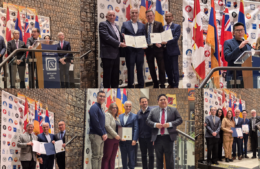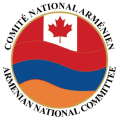Armenians in Transylvania, Hungary: Changing Identities – Changing Communities
- (0)

By Leon Aslanov
The Armenian population which settled in the Carpathian Basin in the Middle Ages mainly consisted of merchant families. Later, in the 17th century, the region saw another significant influx of Armenians, and thereafter a handful of relatively large Armenian communities flourished. This led to issues regarding the management of these groups vis-à-vis the social, cultural and political milieu in which they found themselves. As is the case with any diaspora community, these Armenians conjured myths and historical narratives to reinforce and maintain their unique identity as opposed to the various ethnic groups living in the region. Nevertheless, there are evident discrepancies between the myths created for the (re)construction of identity and the historical accounts that tell the stories of these people. In this lecture, Dr Bálint Kovács sought to deconstruct the identities of the various Armenian communities of the Carpathian Basin by exploring the myths that they held on to and comparing them with the historical record.
Dr Bálint Kovács studied History and Theology at Péter Pázmány Catholic University in Budapest. Since 2008, Kovács has been a research fellow at the Leipzig Institute of East-Central Europe (GWZO) in a research project on the Armenians in East Central Europe. He was curator of the exhibition Far away from Mount Ararat – Armenian Culture in the Carpathian Basin (Budapest, 2013). Kovács defended his PhD thesis at Péter Pázmány Catholic University in 2010, and in October 2016 was appointed head of the new Department of Armenian Studies at the University. This lecture was organised by Dr Krikor Moskofian (Director of the Programme of Armenian Studies), and chairing the event was Adham Smart.
Preliminary history
Tradition has it that 3,000 Armenian families settled in Transylvania in the 17th century. However, no census records from that period remain, and so our current estimation relies on the censuses of the early 18th century, according to which the proposed figure of 3,000 is massively inflated, 240 being a more realistic number. The story of 3,000 Armenian families migrating together to Transylvania is emblematic of the usage of myths to solidify national identity, and indeed, the number 3,000 appears in other myths native to the region. For example, according to the chronicles of Simon of Kéza, the most renowned Hungarian chronicler of the 13th century, the Szekler (a sub-group of the Hungarian nation) are descended from 3,000 Hun warriors of Prince Csaba army, who, after losing a battle, hid in the well of Czygla and went on to give rise to the Szekler people.
Historical accounts refer to at least four towns in Transylvania with significant Armenian populations and an Armenian church. Each town was known by four or five names in different languages (Latin, Hungarian, Romanian, German and Armenian), the most prominent of these towns being Armenopolis (Szamosújvár/Gherla/Armenierstadt/Hayakaghak). Transylvania was a semi-independent country within the Ottoman and Habsburg empires at the end of the 16th and during the 17th century, and the pull of the economically successful Carpathian Basin drew Armenian families from these four towns. Legend has it that the Prince of Transylvania invited Armenians, who were well-known as merchants in the region, to settle in the Carpathian Basin and gave them special privileges. However, this story is unverified.
An extremely important turning point in the formation of the unique identity of the Armenian communities of the Carpathian Basin was the union of the Armenian Church with the Roman Catholic Church. A significant figure in this regard was Oxendio Viriresco. Born around 1655 and Catholicised as child, he become a seminarist later in life, and first came to Transylvania as a priest. He would go on to be involved in the union of the Armenian Church in Hungary with Rome, and is often mentioned in Transylvanian Armenian historiography. His attempts to convert his “heretic” compatriots to Catholicism were met with resistance, and there are even accounts of Armenians interrupting the sermons at the church where Oxendio was a priest. Later, Oxendio received the support of a Hungarian Roman Catholic priest to gain control over an Armenian Apostolic church, after which he forbade the Armenians to perform badarag.
Contact with other ethnicities in the 18th century
Understanding the relations between Armenians and the host society in Transylvania is of utmost importance when exploring the nature of the development of Armenian identity in the region. Transylvania during the 18th century was a multiethnic region: its three main ethnic groups were Hungarians, Saxons and the Szeklers, who all had recognised privileges, while the Armenians and Romanians competed with these major ethnic groups for higher status, albeit unsuccessfully. The Armenians had volatile relations with both the Saxons and the Szeklers. In 1712 a plague epidemic broke out, afflicting the majority Saxon population of Bistrita; the Saxons blamed the Armenians for the plague, and the city council ordered all Armenians to leave the city within 24 hours. The Armenians left for Armenopolis, prompting Oxendio to send a letter to the mayor of Bistrita comparing the episode to the expulsion of the Jews from Egypt. As for relations between Armenians and Szeklers, tensions existed in the town of Gheorgheni, where Armenians enjoyed privileged social status and Armenian merchants were commercially successful. In 1726 the local authorities banned Armenians from the city marketplace before 8 AM in the summer and 9 AM in the winter, on the basis that Armenians were buying products at a low price early in the day in order to sell them at higher prices later on. Negative perceptions of Armenians are abundant in 18th century sources, and such suspicion and scapegoating is a common phenomenon in societies where a particular group plays a disproportionately large role in economic distribution.
Despite these obstacles, Armenians increasingly began to integrate into the host society, thanks in large part to the religious union with the Catholic Church. In addition, Armenians in 18th century Szeklerland began to switch to the Hungarian language. More and more Armenians earned titles of nobility, and in the first half of the 19th century the liberal Hungarian nobility recognised Armenians as allies to collaborate with the Hungarian middle class. Two generals of Armenian descent, Ernő Kiss and Vilmos Lázár, played prominent roles in the Hungarian Revolution of 1848, and were consequently executed by the Austrian Empire. They were members of the group of generals known as the 13 Martyrs of Arad who were executed for their involvement in the Revolution, and are regarded as Hungarian national heroes.
Ideology of Armenianism
Having found their place in Hungarian society during the 19th century, the intellectuals of the Armenian communities felt the need to explore their identities in order to construct an Armenian ideology in the face of assimilation. This ideology, called ‘Armenianism’, was formalised by the Armenian intellectual Jula Mirza and propagated mainly through the periodical Armenia. In 1895, Jula Mirza delineated six areas which required attention in order to preserve Armenian identity in Transylvania: family, religion, piety, education and teaching, literature, and social and public life. Armenianism was defined as the proactive maintenance of these traditions with the aim of preserving the Armenian character, and Hungarian patriotism could thus be complemented by an Armenian way of life.
Jula Mirza’s patriotic movement relied on heavy emphasis on Armenian history and the uniqueness of the Armenian people as distinguished from the Hungarians. Mirza felt that the main force behind the ongoing assimilation was the dwindling Armenian language, as more and more Armenians were switching to Hungarian as a native tongue. Mirza also considered the strengthening of Armenian Catholic identity to be key to the maintenance of Armenianness within Hungarian society, as it allowed for both national preservation on the one hand and religious integration with the host society on the other.
Besides Jula Mirza’s efforts and the publication of Armenia, an Armenian museum was opened in Armenopolis in the late 19th century. It housed objects, library items and money linked to Armenia and its culture. Continuous efforts were made to collect memorabilia, and donations were regularly accepted by the museum to preserve this house of Armenian culture.
In addition, the enchanting power of the ancient city of Ani, symbol of a glorious bygone era, pervaded the consciousness of Armenians in Central and Eastern Europe, and has played an enormous role in the construction of their identity. The source of some of these sentiments was Minas Bjishkiants, a Mekhitarist monk who travelled to Eastern Europe in the middle of the 19th century. Though he himself had not seen Ani, he disseminated the knowledge of the history of the long-gone city which he had studied; in his travel account of 1850 he describes the six occupations of Ani and the origins of the exodus of Armenians. In Dr Kovács’s opinion it is his travel account that inspired the Transylvanian Armenians to claim their descent from the inhabitants of Ani, and the city was thus established as a landmark in the collective consciousness of Transylvanian Armenians from the second half of the 19th century. Nevertheless, in real historical terms, it is highly unlikely that all the Armenians who settled in Transylvania would be able to trace their origins to Ani, since the population of is composed of the descendants of several waves of Armenian migrants from different geographical regions. Nevertheless, the ideological power of a common ancestry from a particular place provided some social cohesion to the Armenian community in Transylvania, which had lost much of its language and traditions.
Armenians in Hungary after the Genocide
The next large wave of Armenian migrants to the region came as a result of the Genocide. These migrants settled both in Hungary and in Transylvania, once it had separated from Hungary and become part of Romania. Mekhitarists in Transylvania looked forward to seeing Armenian blood in the region “refreshed”, and to the founding of Armenian-oriented establishments, such as carpet shops, which would bring back an Armenian feel to cities like Gherla (Armenopolis).
Armenians in Budapest became renowned for their carpet-making skills, and Armenians walking around the city with carpets on their shoulders was a common sight. Armenians in the city were able to accumulate social capital thanks to the success of their endeavours in the economic and social life of Budapest, and the social networks that they built were crucial to their integration – Armenians lived not as complete foreigners, but were rather woven into the fabric of Budapest society. They were also very much in contact with other Armenian diaspora communities; at the Armenian Catholic Church of Budapest one may find Armenian newspapers from all around the world, suggesting that they were read by local Armenians.
The founding of a number of institutions of great import in the 1920s marked a turning point for the community life of Armenians in Budapest. The first Armenian institution established in Budapest was the Association of Hungarian Armenians, founded by migrants from Transylvania. The second was an Armenian-Hungarian commercial shareholding company established to bring money from the Armenian diaspora to Budapest. Alongside the company’s commercial interests, it also provided scholarships to fund the studies of young Armenians. The Massis Association, important in the cultural life of Armenians in Budapest, published a just called Nor Dar (‘New Letter’), which informed its readers of the conditions of Armenians around the world in the Armenian language.
Identity conflict between Transylvanian and ‘new’ Armenians
The Armenians who had arrived in Transylvania in the 17th and 18th centuries had been negotiating their communal identity vis-à-vis Hungarian society for centuries, and their identity, culture and mindset had undergone great changes since their exodus from their homelands. The arrival of Armenians after the Genocide brought with it tensions between the ‘new’ and ‘old’ communities which have persisted until today, and differing degrees of preservation of Armenian identity and assimilation into Hungarian society can still be observed. The old Armenians had more or less totally assimilated and adopted Hungarian as their native language by the time the new Armenians arrived, bringing with them their Armenian dialects. The old Armenians see Transylvania as their close homeland, with their distant homeland of Ani standing as the symbol of their core identity. In contrast, the newcomers still retain real memories of their homes in Anatolia and, of course, their experiences of the Genocide.
Some of the conflicts that arise within the different segments of the Armenian community in Hungary may be a consequence of the national law on minorities. Minority recognition requires the minority to know its mother tongue and to have been settled in Hungary for at least a hundred years. The status of a recognised minority would entitle Armenians to financial support from the state directed at communal activities that help to maintain cultural institutions.
The history of Armenians in the Carpathian Basin is one of different waves of migration, of a variety of experiences in relation to Hungarian society. The historical reality is that Armenians initially found it difficult to settle in Transylvania, and tensions between them and the local people were evident. Armenians felt the need to integrate into the host society, but many “Armenian elements”, such as language, religion and traditions, were diluted or lost along the road to integration. The ideology of Armenianism propagated by Jula Mirza sought to revitalise Armenian identity in the Carpathian Basin through intellectual efforts, and in due course Armenian institutions were established to revitalise and preserve the population’s Armenianness. The second large wave of Armenian arrived as a result of the Genocide, and the newcomers found themselves at odds with those Armenians who had been integrating into Hungarian society for centuries. This division among the Armenians of Hungary exists to this day, and has expanded to include the Armenians from the Soviet Union who began to migrate to Hungary with the eruption of the Karabakh conflict. The issues of Hungarian-Armenian identity are a multilayered affair, and depending on the time of a particular group’s arrival in Hungary, assimilation to Hungarian society exists in varying degrees




















